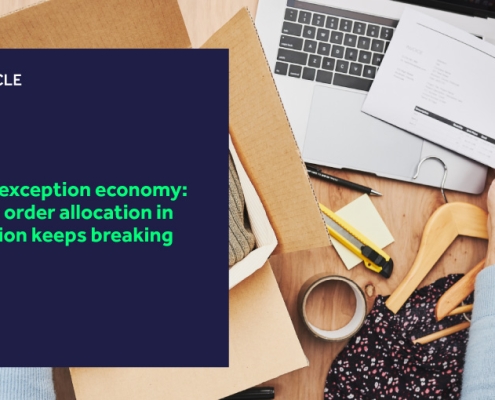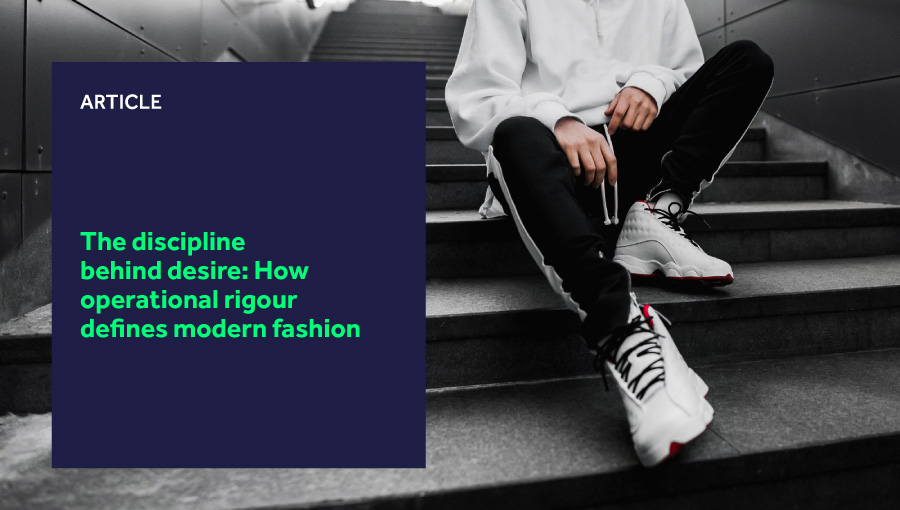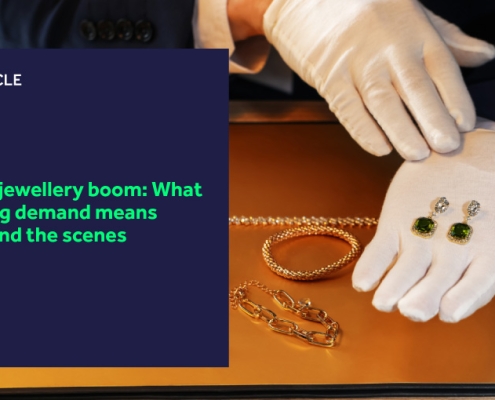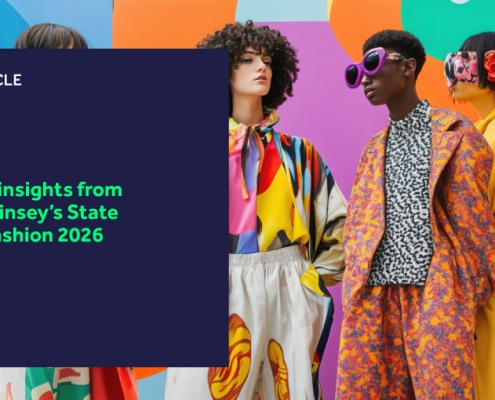Operational rigour isn’t the flashiest term around right now, but it is what has built the most resilient fashion brands over the past five years. It’s also exposed the fragility of legacy brands.
While fashion giants have battled with overflowing warehouses, endless promotions and bleeding margins, newer labels have grown with tight assortments, disciplined releases and clear operating habits.
Inventory sits at the centre of it all.
For legacy players, economic pressures, supply chain hiccups and micro-trends have created wild fluctuations in supply and demand. The resulting burden of excess stock has ultimately eaten into profits and eroded pricing power.
It’s a clear sign that chasing growth-at-all-costs with weak operating habits is no longer going to cut it, especially when you zoom out and look at the wider landscape.
Running before you can see
The industry talks loudly about forecasting tools, but the harder work is better inventory practice and establishing the operational backbone that makes it possible.
Most teams analyse numbers across scattered platforms. They add another point solution and expect clarity… but invariably decisions slow and accountability blurs. Put the pieces in one place and you get a single view of what’s made, where it sits, and where it should go next.
Information isn’t the main issue, though. It’s how fast an organisation can act on it. Smaller, nimble brands vastly outmanoeuvre the giants because their models and principles are different.
Legacy brands scaled on wholesale, long lead times, and large seasonal buys, then struggled when tastes moved and stock couldn’t be shifted. In contrast, newer labels kept their assortments tight, released in controlled drops, and protected full-price sell-through.
The crux of it, though, is that legacy supply chains simply can’t pivot quickly enough. They were built for massive year-round production schedules to feed retailers and owned stores.
Even if legacy brands released limited editions or capsule runs, those drops ultimately sit atop a fixed, high-volume core. Their machines were created for continuity, not responsiveness.
Conversely, the likes of Represent, Fear of God ESSENTIALS, Aimé Leon Dore, and Rhude built demand with discipline. Their models rely on fewer SKUs, repeatable winners, limited releases, and communities that signal demand before production commits.
Scarcity isn’t a marketing gimmick for them; it’s an operating rule.
Yes, these mid-market brands play in a different realm to the likes of Nike, Adidas and other global titans, but there are many lessons to be learnt from their operating rules that can be applied to the big boys.
Two playbooks, two outcomes
During the pandemic, Represent had two million dollars worth of wholesale orders cancelled. The choice it made next – selling via weekly direct releases on Instagram – meant it not only sold all the items, but deepened relationships with customers and propelled its growth.
On the flip side, Nike got stuck with its infamous 44% year-on-year inventory surge in 2022. Promotions naturally followed to clear the excess, and its gross margin fell towards decade-low territory. There’s something important to note on this cautionary tale, though:
Nike had seen a huge demand spike of 65% prior to getting stuck with its overproduced staples. The problem was that it decided to go full tilt and fulfil that demand, only for consumer spending to plummet, and before long, its supply far outstripped the demand.
These are two wildly different brands in different niches with different playbooks and outcomes. But both offer lessons. In the Nike story, we see fully why endless promotions trigger spirals.
Heavy discounts dull pricing power and condition customers to wait for more sales.
Distribution channels can quite often compound the effect, too. Wide wholesale networks can spill product into off-price channels, and brand value erodes with each promo. Ironically, though, Nike’s decision to pull out of wholesale under John Donahoe further worsened its situation (something that is now slowly being course-corrected by new CEO Elliott Hill).
That’s because wholesale isn’t inherently bad. Several new-wave brands have grown with selective partners while keeping their centre of gravity direct to limit markdown exposure and keep the brand value and positioning clean.
Represent is a great example. It does have wholesale partners, but they’re selective. It also handles discounting wisely via the ‘Vault’ events, which give limited access to past pieces and are often aimed at members rather than the mass market. This means price brackets stay targeted, baskets get larger, and brand popularity soars.
The brand’s sales are marketed as exclusive events for fans and members, while the Prestige loyalty programme allows hardcore enthusiasts to redeem points for discounts. This effectively gives much of the price breaks to only engaged community members and not the general public. This way, any ‘necessary’ markdowns are targeted and discreet.
Nike obviously had far too much excess inventory and too little time to find a smarter way to discount, but that isn’t the point. Many of these new-wave brands are scarce by design, which limits the risk of overproduction, whereas Nike’s chase-growth-at-all-costs model means it constantly says yes to whatever demand there is, regardless of potential consequences.
It’s a reminder for legacy brands that the once-tried-and-true playbooks may not always work.
Distribution without dilution
Limiting fire sales is one surefire way to protect brand integrity and price positioning, but it is only one piece in a much larger puzzle. Channel strategy, for instance, also matters.
Direct brings higher margins and control over presentation, but also the burden of fulfilment, returns and acquisition costs. Wholesale opens audiences and shares the operational load, but also lengthens cash cycles and surrenders pricing discipline to others.
The balance is brand-specific, but clarity on roles saves you from channel cannibalisation.
One practical way to keep that balance is to differentiate product lines by channel. Unique items per store or partner protect each route to market and prevent one channel from undercutting another. Represent’s London and Manchester shops already do this, offering exclusive pieces that justify the visit and keep wholesale and DTC collections distinct.
Other new-wave mid-market brands like Aimé Leon Dore, Fear of God ESSENTIALS and Rhude also mostly avoid traditional multi-brand retail markdown cycles because they keep the bulk of their sales direct or in a few high-end boutiques.
Aimé Leon Dore, for instance, deliberately parted ways with most third-party stockists in 2020 to focus on its own stores and eCommerce, and now its pricing power is stable.
The key point being that controlled distribution is paramount to keeping products out of clearance bins. AllSaints aggressively expanded with stores and wholesale to make sure everyone wore the brand many years ago, and succeeded. It was ubiquitous among the youth.
But now, it isn’t uncommon to see AllSaints massively discounted during end-of-season sales. AllSaints, to be fair, is still in a strong position, and this is because, as CEO Peter Wood said last year, it has focused on wholesale, franchise and licensing partnerships to offset declining physical retail sales and navigate challenging market conditions.
AllSaints’ pivot serves to remind the market that flexibility in channel strategy is essential to remaining competitive. Think back to how Represent made the decision to go direct after its wholesale orders were cancelled, or how Nike pulled out of wholesale and had to reverse it.
When scale becomes the enemy
Bjørn Gulden’s reign at Adidas offers another great lens on course correction. The legacy model, i.e., the one used by Nike and Adidas, struggles with trend swings in fashion. These brands chased athleisure and chunky silhouettes only to be left with excess stock when tastes moved.
Adidas learned this the hard way with Yeezy.
After cutting ties with Kanye West, it was left with billions in unsellable shoes. Some pairs were eventually sold for charity, but the write-off showed how SKU sprawl magnifies risk.
Under Gulden, though, Adidas cut back excess SKUs (unpopular models and colourways) and leaned heavily into popular models like the Samba and Gazelle instead of endless variants. Margins swiftly improved as the mix cleaned up.
This, in principle, is like applying a lean SKU mindset, but at a much, much bigger scale.
It’s proof that even the legacy giants who turn over millions of SKUs each season can still adopt operational rigour and lean SKU mindsets amidst turbulent markets. While Nike continues to discount, Adidas has effectively regained some pricing power by cutting back on discounts.
Operational discipline and lean inventory strategies allow growth without handing margin to markdowns. Fundamentals, like demand planning, controlled SKU counts, and loyal communities, will always be king and brands should never forget this.
Backbone before brilliance
None of this works without the right infrastructure. Represent learned this the hard way. Its first ERP implementation attempt failed, visibility suffered, and manual workarounds crept in. It had to employ a specialist to integrate its ERP with its Shopify, 3PL and PLM systems. Then, once the core was tightened, it had access to SKU-level clarity and faster restocks.
There’s often a temptation in fashion to make forecasting a hero. But forecasts are only ever as good as the data fed into them and the people making decisions based on the output.
It’s not like the legacy players don’t have ERP and other tech already implemented. These players, again we’ll take Nike as an example, have long started their AI and predictive analytics journeys. Yet, the past few years have reminded everyone that models can’t see everything.
Inflation, geopolitical shocks and sudden mood swings sit outside normal ranges. Sure, the tools still help, but they help most when the information used is clean, current and shared.
Perhaps more importantly, data still requires smart decisions from the people reading it.
A predictive algorithm might have shown Nike that a sudden 65% demand spike wasn’t going to last, but its growth-at-all-costs mindset probably would have superseded the decision to hold back that demand anyway.
Sometimes the best demand gauge comes from the community. Represent’s Prestige programme and social signals help to size drops. Often, its drops sell out overnight. This speaks to the value of a known base and a direct line to them.
Forecasting alone didn’t deliver that result. The operating cadence did.
Operational discipline also helps guard brand equity. Luxury houses have long protected price and placement, sometimes in unsustainable ways, and streetwear-led labels translated the lesson into modern practice by not overproducing in the first place.
Legacy names are relearning the cost of noise, then pulling back from channels and SKUs that force constant sales activity.
Of course, operational excellence doesn’t create desire on its own.
A system can run perfectly and still sell the wrong thing. There is a fair counterpoint, though. Brands like these new-wave mid-market upstarts didn’t win through discipline alone.
They built clear identities, then matched operations to that promise. Strong design and community made the flywheel worth powering. So, the point stands that operational slack squanders brand heat, while rigour converts it into stable growth.
The new-wave mid-market upstart manual
If you lead a fashion business, the playbook from these upstarts is simple but hard to ignore. Lean more toward scarcity. Lost sales hurt much less than months of markdowns and diluted perception. In the same vein, control the SKU count. Carry a tight core, reissue proven styles in new ways, and avoid line bloat that creates forecasts without clarity or intent.
(Fear of God ESSENTIALS has explicitly engineered low inventory risk this way. It reissues popular items in new colours or slight variations, rather than gambling on new styles – a strategy pioneered by Supreme. This is, in effect, SKU lifecycle management by refinement, not reinvention.)
Invest in the backbone
Product development, stock, orders, fulfilment and finance must be conjoined in one system to reduce reconciliation, shorten feedback loops and keep everyone working from the same numbers. Yes, this is ERP, and yes, it’s unglamorous, but it’s the only way to coordinate across functions reliably.
Treat forecasting as support, not a saviour
Use it to inform decisions, then keep human judgement in the loop when the world shifts. When the signal changes, cut orders early, move inventory decisively, and protect price where demand still holds.
Build membership engines with substance
Reward loyalty, talk directly, and use size releases based on what members tell you by behaviour, then keep broader discounts out of the spotlight. Your best customers will spend more, more often, when the relationship feels earned.
Scale equals more discipline
Supreme’s post-acquisition wobble by VF Corp showed how hard it is to widen distribution and keep the edge. Others, like Represent and Aimé Leon Dore, brought in experienced operators and strengthened systems before the cracks appeared.
Act early, stay focused, and make infrastructure a strategic choice.
Speed needs structure
All this isn’t to say that the latest cool tech innovations are rubbish and a waste of money, but that they are supplements that require a solid infrastructure first and tight operating principles that must be combined alongside human judgement to make them really work.
ERPs are, in this way, road networks built for load and built to last. AI and predictive algorithms are the fast cars that ride on these networks. Without solid roads, speed only multiplies risk. With them, you move quickly, with fewer surprises, and you arrive with margin intact.
Fashion will always reward taste and timing. The brands that endure pair those virtues with operational habits that look boring from the outside, then compound year after year. The next wave won’t be the loudest; it will be the ones that run their business cleanly, protect price, and keep stock in line with demand.
We shouldn’t pretend that Represent, Aimé Leon Dore, or Fear of God ESSENTIALS are in the same stratosphere as Nike, Adidas and the like. The latter have enormous reach, enviable brand equity, and staying power that is seldom matched. But Adidas’ switch to a leaner SKU mindset is proof that the operational principles employed by the former are winning strategies.
Quiet work builds endurance
Operational rigour isn’t a constraint on creativity. It’s the support that lets designers and marketers take smarter risks, safe in the knowledge that the system can flex without breaking. The work happens far from the runway, quietly, in the numbers and warehouses.
For leaders willing to take the long view, the path is clear. Tighten the line, choose partners carefully, invest in systems that connect your business, and give your teams the context to decide well. Brands that do this will keep their culture strong and their margins stronger.
This is the real backbone of modern fashion. Not a slogan, not a campaign, but the discipline to make and move product with intent, season after season, without losing the thread.
Enjoyed reading this? We regularly publish our perspective on the latest in fashion, which you can read here.
 https://k3fashionsolutions.com/wp-content/uploads/2025/11/exception-economy-featured.jpg
510
900
Jordan Heal
https://k3fashionsolutions.com/wp-content/uploads/2024/12/K3_Fashion_Solutions_Half-color_RGB.svg
Jordan Heal2025-11-25 09:41:202025-11-25 09:41:20The exception economy: Why order allocation in fashion keeps breaking
https://k3fashionsolutions.com/wp-content/uploads/2025/11/exception-economy-featured.jpg
510
900
Jordan Heal
https://k3fashionsolutions.com/wp-content/uploads/2024/12/K3_Fashion_Solutions_Half-color_RGB.svg
Jordan Heal2025-11-25 09:41:202025-11-25 09:41:20The exception economy: Why order allocation in fashion keeps breaking


